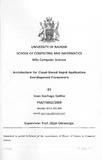| dc.description.abstract | Application developers currently have a wide selection of rich application development tools to
use. These tools have a common limitation in that they require some hardware, which is mostly
high end, and base software to run. While these may not appear like major challenges to software
development companies, startup companies and individuals, students and trainers among others
may find this requirement prohibiting. In a world where most innovative ideas have come from
campus rooms, it is critical to have development environments that are easily accessible and
whose cost is minimal or at least dependent on the usage. Other than startup cost, developers are
also faced with the nightmare of managing development platform migration every time they
switch development computers or re-install the operating system. This goes hand in hand with
the fact that development is limited to the single development computer that has the development
tools installed. Developers are hence not able to make changes on the fly without having to
access their development computers.
In this report we look at a viable architecture of a cloud based rapid application development
framework. Cloud platform transforms the way computing resources are utilized avoiding the
need for upfront purchase of fundamental hardware and software. Having a development
environment that runs off the cloud and accessible through the browser helps address the
challenges faced under the current development environments. Accessibility of such platforms as
well as data security become the immediate problems that a developer is likely to be faced with.
These have however been mitigated by use of rich client and asynchronous server access that
reduces traffic requirements when developing on the platform. By using single sign-on for user
authentication based on known and reliable authentication services, the environment addresses
the security issue.
The results of the surveys conducted have clearly indicated willingness by developers to migrate
to a cloud based development environment if guaranteed to have features that match locally
installed development environments. This dissertation demonstrates the practicality of a cloud
based application development framework through the proposed design, prototype development
and user surveys. | en |

